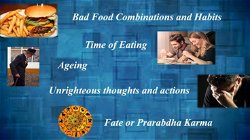Art of Eating and It's Great Health Benefits
Ayurveda
. 7 min read
This article has been taken from main series- Science of Human Wellness, The Complete Health Series, which is a step by step illustration on Health, Yoga and Ayurveda. Maybe you want to lose weight or gain weight, fight with reflux or acidity, seasonal allergies or other long ailments, all it can be achieved by practicing Art of Eating. This is long left-behind science which include five basic senses/manners of eating, diet according to seasonal changes and according to your inherent constitution and following transforming aspects of common-sense of eating, which are very simple and easy.
Anika, A Beautiful Girl- Her Desperate Fight with Obesity
Anika, a girl in her mid-twenties, was depressed and her feelings were very logical. She was overweight by 12 KG and despite all her physical and dietary efforts, she couldn’t lose the weight. She’d tried fasting, supplements, Calories Control, cut back on sugars and starches, avoiding junk food, Fat burning workouts, sticking completely to vegetarian diet for continuously two year and everything she could possibly think of to help. Every time she lost a few KG, she gained back quicker than she lost them. From the constant low voltage stress of everyday caused due to inferiority complex she was in unavoidable crisis and was literally crying to god in front of me, “Oh God! why can’t you lose my weight?” I chuckled softly, “God cannot put whole existence aside to lose 12kG weight of a maiden, after-all what the God has to do with your weight”. Indeed she wanted me to feel the gravity of situation and her concern was not unreasonable. She was a fair colored lady with attractive features but all these qualities were appearing obliterated due to being too gross and heavy. Her parents were planning her marriage and were looking for a better match and she couldn’t afford to seem unattractive. Her Condition was at its worst, she would repeatedly check her appearances in the mirror and would feel ugly about herself. She asked me, “Can you please help me out?”, I said, “Yes”. She asked, “Will you give a dietary chart or dictate some exercises or yoga practices?”, I replied, “No, not at all, as these things you have already tried and will not give permanent solution in your case, quality, amount and selection of food really matters but not always lead to desired result”. She said, “I couldn’t make out, what is left then”, I told her that, “all you need to know is art of eating, follow the long-forgotten eating sense and its principles.” She was convinced and pursued guidelines in honest manner. In first three months she reduced 5 KG weight and in very next quarter she could lose 8 KG which was even better than her expectation.
These are the Basics Aspects of ‘Art of Eating’
Here I will explain some elementary styles of eating or basic sense of eating; you may be a hardcore non-vegetarian or a fonder of sweet dishes but when when millions of people can enjoy good health with such things throughout life then why can’t you. Of-Course you can and you should! It is not that difficult just sink into art of eating and by doing it yourself. Five Basic Aspects of Art of Eating:Serial NumberProspectWay it should be practiced 1 Drinking Water Half an hour before eating meal water is like nectar, because its intake induces the secretion of saliva, digestive enzymes in efficient manner. If we take water during the meal it is like medicine as it helps in liquefying the meal. But it is not necessary since neither is does any harm nor it gives great benefits. It is advised that a person should take water during meal only if there is no fluid diet in the meal. Immediately after meal water is like a poison as it leads to dilution of gastric juices, causing indigestion. By this act liver and pancreas are forced to secrete more enzymes. 2 Quantity of Meal Out of four parts, take two parts of solid food, one-fourth of liquid and one part of air, naturally occurring nutrients like milk help body recognising the satiety instantly because your body knows how to break netural molecules enough, and you cannot overeat them, which is reverse in case of junk or synthetic juices (fizzy, pepsi, coca-cola etc.) and when brain realize satiety i.e. it is time to stop, you may have already eaten an excessive amount. 3 Watchful Mind The easiest way to know how much you should eat is to eat mindfully, chew properly and pay thorough attention to what and how much you're eating. Also when you drink water then take sip by sip i.e. like as if you are eating solid food; and when you are eating, chew your meal so much that it almost becomes liquid. 4 Time of Eating Ayurvedic texts state that eat your dinner four hours before you go to sleep; before or around to sunset is strongly recommended. Eating late or just before sleeping is a way of aggravating the three doshas and leads to weight gain. Eat only after the previous meal has been fully digested; give 4-5 hours gap between two meals and avoid irregular mealtime. 5 Expressing Gratitude before meal This is very scientific practice as it puts your brain and physical body in alignment while you are eating and results in digestion of food in best manner. Thank mother nature who has enabled you to have food, unlike millions on planet earth who go to bed hungry every night. Bring thought in your mind that you will enjoy every morsel and accept it as gift from nature. Take few sips of water, pacify your body and breathing. Thoroughly chew every bite, put all the hurries and worries, pending works and talks aside and remain in gratitude while you are eating. also invoke millions and millions of microorganisms in the food and inside your body to help nourish you and strengthen you. If possible then it is always good to set aside few mouthfuls to later give it to cow, dog, birds or other creatures.
Transforming Aspects of Common-Sense Eating
- Chew your food 15-25 times with each bite. Putting your fork down between bites of food is an excellent complement to the chewing habit and gives great health benefits.
- Eat like a lion, observe the grace in their motion on discovery or Nat Geo. You will find no haphazard movements and they eat as if they are savouring every bite or enjoying their feast in kingly manner. Those who eat like lion are the finest eaters, those who eat in hurry and remain restless while eating, are comparable to a dog because this is how dog eats; their stomach will be strained; stomach is not designed for tearing and grinding, if there are larger chunks of food then your body has to secrete more enzymes. Also don't be too slow like a cow as your most of food will be cold by the time it gets to your stomach. If food is below the body temperature, your body has to heat up the food in order to break it down which again will put burden on your stomach. If you maintain a steady pace while eating you will see your health improving day by day.
- When you eat then don’t engage yourself with TV, News Paper, Talking on phone, working on computer, busy on facebook or other social media or any other activity making you ignorant about the amount and quality with which you are eating.
- Postpone meal for few minutes when you are extremely stressed out, you should be cheerful, carefree, contented and in fine mental state when eating.
- Don’t eat stale food, try to consume fresh food cooked not more than 30-60 minutes earlier.
- Traditional dining etiquette of India of eating together with family had profound reasoning and if followed then adds important aspects: Family dinners mean better family relationships since not only it strengthen family bonds but also leads to healthier food choices. Research has shown that children who eat with their parents likely to be emotionally strong and have better mental health. Also this the psychological fact that when you eat in a group then you give it more importance and place in your day to day life.
Correlation Between Diet and Changing Season
Our bodies undergo hormonal changes as the season changes. The shift in periods of light and darkness that occur have profound effects on our circadian rhythms. Staying healthy with the changing seasons can be achieved by adopting light food i.e. avoiding processed, fried, fatty and fast foods. For great health benefits prefer gluten-and-dairy-free diet for one week during the change in season. In India Navratras are celebrated two times in a year during season change, science behind this is that, people work to harmonize themselves with mother nature, since if you enter season healthy, you will remain healthy throughout the season. During season change your immune system remains weak and you undergo inner transformation.
Tridoshas and Seasons
Vata, Pitta and Kapha-governs not only our own constitution, but everything else in the whole cosmos. everything that exists in nature, there is always a beginning which is represented by kapha, a middle represented by pitta and an end or dissolution in regards to time represented by Vata. We have already read about Tridosha and constitutions in previous articles and If we have good knowledge of Tridoshas and about our basic constitution then we can utilize seasons to pacify or balance our Doshas. Indeed different ailments related to different dosha arises in different seasons. For example Vata ailments arises in rainy season and pacified in autumn, Pitta appears during spring or summer and pacified in autumn, kapha accumulates in winter and manifest its disorders in spring. Seasons and the Doshas: Name of Dosha Accumulation of Dosha Manifestation of Disorder due to accumulated dosha Pacifies during Related Ailments Vata Summer Rainy Autumn Hiccups, Bronchitis, Asthma, diseases related to eye, ear, nose and throat, indigestion, Diarrhea, disease related to bladder, circulatory system, fever, anus, testicles, urinary, diabetes etc. Pitta Spring Summer Autumn Indigestion, Anorexia, Anemia, Jaundice and Hepatitis, Mental disturbances, Cardiac problems, disability in vision, Leucoderma and other skin diseases. Kapha Winter Spring Summer Disability of digestion, Lethargy, disability in digestion, problems related to nervous system and sense organs, Memory loss, dysfunction of joints etc.
Above article has been taken from main series- Science of Human Wellness, The Complete Health Series.
More Stories from
The Ayurvedic Diet: What to Eat for Wellness and Longevity?
Restoring pH balance in the body is important as imbalance may lead to either acidosis or alkalosis. More sattvic food you eat, healthier your body will be.
Five Great Causes of a Disease and Their Remedy in Ayurveda
Five fundamental causes of disease are: Bad Food Combinations and Habits, Time of Eating, Ageing, Unrighteous thoughts and actions and Fate or Prarabdha Karma.
Sattvic, Rajasic and Tamasic Foods-Yogic Diet and Effect
Whole dietary concept in Ayurveda is divided into Sattvic, Rajasic and Tamasic foods and says that
Need & Advantages of Yoga and Ayurveda for better Health
Yoga and Ayurveda have great scientific, solve medical and scientific mysteries in light of Yoga and Ayurveda. Advantages of Yoga and Ayurveda, Health.
Fundamentals of Ayurveda, Pancha Bhoota, Sapta Dhatus,Tridosha
Fundamentals of Ayurveda, Pancha Tattwa or Five Elements, Sapta Dhatus, Tridosha or Three Humours, yoga and Ayurveda, Ayurvedic treatment, yoga every day






